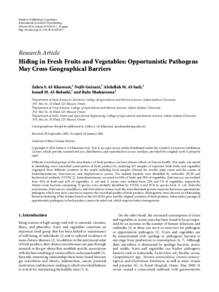وثيقة
Hiding in fresh fruits and vegetables : opportunistic pathogens may cross geographical barriers.
المعرف
DOI: 10.1155/2016/4292417
المساهمون
Guizani, Nejib., مؤلف
Al-Sadi, Abdullah M., مؤلف
Al-Bulushi, Ismail M., مؤلف
Shaharoona, Baby., مؤلف
الناشر
Hindawi.
ميلادي
2016-02
اللغة
الأنجليزية
الموضوع
الملخص الإنجليزي
Different microbial groups of the microbiome of fresh produce can have diverse effects on human health. This study was aimed at identifying some microbial communities of fresh produce by analyzing 105 samples of imported fresh fruits and vegetables originated from different countries in the world including local samples (Oman) for aerobic plate count and the counts of Enterobacteriaceae, Enterococcus, and Staphylococcus aureus. The isolated bacteria were identified by molecular (PCR) and biochemical methods (VITEK 2). Enterobacteriaceae occurred in 60% of fruits and 91% of vegetables. Enterococcus was isolated from 20% of fruits and 42% of vegetables. E. coli and S. aureus were isolated from 22% and 7% of vegetables, respectively. Ninety-seven bacteria comprising 21 species were similarly identified by VITEK 2 and PCR to species level. E. coli, Klebsiella pneumoniae, Enterococcus casseliflavus, and Enterobacter cloacae were the most abundant species; many are known as opportunistic pathogens which may raise concern to improve the microbial quality of fresh produce. Phylogenetic trees showed no relationship between clustering of the isolates based on the 16S rRNA gene and the original countries of fresh produce. Intercountry passage of opportunistic pathogens in fresh produce cannot be ruled out, which requires better management.
المجموعة
ISSN
1687-918X
URL المصدر
قالب العنصر
مقالات الدوريات

